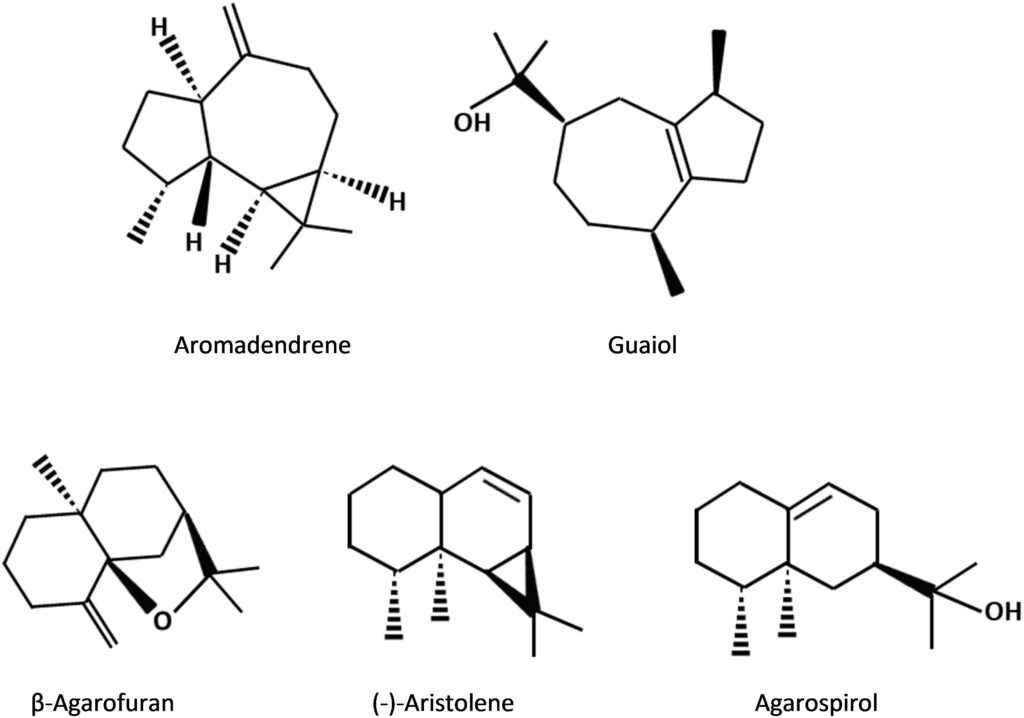Table of Contents
ToggleAgarwood Oil are the most expensive oil which is generally found in India, Indonesia, south east country, etc. Agar word represented the scent or fragrances. It is commonly called as Oud, agar, ood, aloes wood, eaglewood, gahuru, jinkoh. The scientific name for agarwood is Aquilaria crassna.

Agarwood Oil
Agarwood, also known as aloeswood, eaglewood, gharuwood, or the Wood of Gods, is a fragrant, black, and resinous wood that is used in small hand carvings, incense, and perfume. It is most generally referred to as oud or oudh (from Arabic: عود, romanized: ʿūd, pronounced [ʕuːd]). It develops in the heartwood of Aquilaria trees when P. parasitica, a kind of Phaeoacremonium mold, infects them. To fight the fungal invasion, the tree secretes a resin in a defensive manner.
What is agarwood oil?
The scientific name for agarwood oil is Aquilaria malaccensis, and it is obtained by steam distillation from the damaged wood of agarwood trees.
What are the types of agarwood?
There are three types of agarwood. They are:
- Aquilaria malaccensis
- Aquilaria crassna
- Aquilaria sinensis
How agarwood essential oil is made?
Agar is derived from resin deposits that accumulate in the heart of some tree species in response to environmental stressors like fungal infections or insect damage. Steam distillation or solvent extraction are two methods used to extract essential oils from agarwood chips. In both cases, steam or a solvent is passed through the wood chips. The extraction process and the grade of the agarwood utilized determine the oil’s quality.
The oil is extracted from the wood chips by heating them with steam, and the oil is subsequently collected and condensed into a liquid. In contrast, a chemical solvent is used in solvent extraction to dissolve the oil in wood chips. There are several applications for the highly concentrated oil that is produced.
History of agarwood oil
Agarwood has a rich, pleasant scent that has few or no natural counterparts. The aroma is primarily identified in its perfumed stage by a blend of “oriental-woody” and “very soft fruity-floral” elements. Amber (not to be confused with ambergris) and “shades of vanilla and musk” are further characteristics of the incense smoke. It also has a “sweet-balsamic” aroma. Because of this, agarwood and its essential oil acquired significant cultural and religious value in prehistoric societies all over the world. The Indian Vedas mention agarwood as a fragrant commodity as early as 1400 BCE.
The Hebrew Bible has references to “trees of lign aloes” in The Book of Numbers 24:6 and Psalms describes a perfume made of aloeswood, myrrh, and cassia.
Application of agarwood oil
Agarwood is a resinous part of the non-timber Aquilaria tree, which is highly valuable product for medicine and fragrance purposes: They are:
- Neural activity
- Anti-inflammatory
- gastrointestinal regulation
- antibacterial activity
- antifungal activity
- analgesic activity
- cytotoxicity
- anti-diabetes
- antioxidant activity
Chemical Composition
The major composition of agarwood oil are:
- Valerianol
- alpha-eudesmol
- beta-eudesmol
- gamma-eudesmol
- 10-epi-gamma-eudesmol
- dehydrofukinone
- aromadendrene
- agarospiral
- beta-agarofuran
- guaiol
- (-) aristolene

Grading types of agarwood oil
There are generally various grade of agarwood oil :
- C, A, AB, A, AA, AAA
- water grading system: 1. regular
- semi-sinking
- half-sinking
- sinking
- fast-sinking
- under-water
Safety
- They are internally not allowed.
- not used as undiluted essential oils
- Not used for pregnant, epileptic, liver damage, cancer.
Real Vs Fake agarwood oil
There are three general idea to detect the pure vs fake oil:
- By the appearance (real is relatively darker color and a less uniform pattern compare to fake ones)
- Scent (is gentle, subtle, long-lasting)
- heat test( sumberge two pieces of wood in hot water and boil them for 2 hours. Real will and release its natural, mild fragrances in water but fake one will not.






